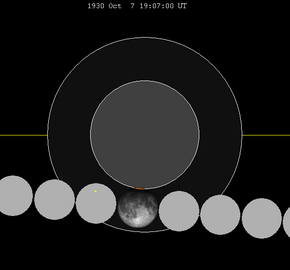A partial lunar eclipse occurred at the Moon’s ascending node of orbit on Tuesday, October 7, 1930,[1] with an umbral magnitude of 0.0253. A lunar eclipse occurs when the Moon moves into the Earth's shadow, causing the Moon to be darkened. A partial lunar eclipse occurs when one part of the Moon is in the Earth's umbra, while the other part is in the Earth's penumbra. Unlike a solar eclipse, which can only be viewed from a relatively small area of the world, a lunar eclipse may be viewed from anywhere on the night side of Earth. Occurring about 4.4 days after apogee (on October 3, 1930, at 9:45 UTC), the Moon's apparent diameter was smaller.[2]
| Partial eclipse | |||||||||||||
 The Moon's hourly motion shown right to left | |||||||||||||
| Date | October 7, 1930 | ||||||||||||
|---|---|---|---|---|---|---|---|---|---|---|---|---|---|
| Gamma | −0.9812 | ||||||||||||
| Magnitude | 0.0253 | ||||||||||||
| Saros cycle | 116 (53 of 73) | ||||||||||||
| Partiality | 38 minutes, 18 seconds | ||||||||||||
| Penumbral | 286 minutes, 38 seconds | ||||||||||||
| |||||||||||||
Visibility
editThe eclipse was completely visible over east Africa, eastern Europe, Asia, and western Australia, seen rising over west Africa, western Europe, and eastern South America and setting over eastern Australia and northeast Asia.[3]
Eclipse details
editShown below is a table displaying details about this particular solar eclipse. It describes various parameters pertaining to this eclipse.[4]
| Parameter | Value |
|---|---|
| Penumbral Magnitude | 1.09067 |
| Umbral Magnitude | 0.02525 |
| Gamma | −0.98118 |
| Sun Right Ascension | 12h50m44.6s |
| Sun Declination | -05°26'30.5" |
| Sun Semi-Diameter | 16'00.5" |
| Sun Equatorial Horizontal Parallax | 08.8" |
| Moon Right Ascension | 00h52m28.2s |
| Moon Declination | +04°38'57.1" |
| Moon Semi-Diameter | 15'01.5" |
| Moon Equatorial Horizontal Parallax | 0°55'08.6" |
| ΔT | 24.1 s |
Eclipse season
editThis eclipse is part of an eclipse season, a period, roughly every six months, when eclipses occur. Only two (or occasionally three) eclipse seasons occur each year, and each season lasts about 35 days and repeats just short of six months (173 days) later; thus two full eclipse seasons always occur each year. Either two or three eclipses happen each eclipse season. In the sequence below, each eclipse is separated by a fortnight.
| October 7 Ascending node (full moon) |
October 21 Descending node (new moon) |
|---|---|
| Partial lunar eclipse Lunar Saros 116 |
Total solar eclipse Solar Saros 142 |
Related eclipses
editEclipses in 1930
edit- A partial lunar eclipse on April 13.
- A hybrid solar eclipse on April 28.
- A partial lunar eclipse on October 7.
- A total solar eclipse on October 21.
Metonic
edit- Preceded by: Lunar eclipse of December 19, 1926
- Followed by: Lunar eclipse of July 26, 1934
Tzolkinex
edit- Preceded by: Lunar eclipse of August 26, 1923
- Followed by: Lunar eclipse of November 18, 1937
Half-Saros
edit- Preceded by: Solar eclipse of October 1, 1921
- Followed by: Solar eclipse of October 12, 1939
Tritos
edit- Preceded by: Lunar eclipse of November 7, 1919
- Followed by: Lunar eclipse of September 5, 1941
Lunar Saros 116
edit- Preceded by: Lunar eclipse of September 26, 1912
- Followed by: Lunar eclipse of October 18, 1948
Inex
edit- Preceded by: Lunar eclipse of October 27, 1901
- Followed by: Lunar eclipse of September 17, 1959
Triad
edit- Preceded by: Lunar eclipse of December 7, 1843
- Followed by: Lunar eclipse of August 7, 2017
Lunar eclipses of 1930–1933
editThis eclipse is a member of a semester series. An eclipse in a semester series of lunar eclipses repeats approximately every 177 days and 4 hours (a semester) at alternating nodes of the Moon's orbit.[5]
The penumbral lunar eclipses on February 10, 1933 and August 5, 1933 occur in the next lunar year eclipse set.
| Lunar eclipse series sets from 1930 to 1933 | ||||||||
|---|---|---|---|---|---|---|---|---|
| Descending node | Ascending node | |||||||
| Saros | Date Viewing |
Type Chart |
Gamma | Saros | Date Viewing |
Type Chart |
Gamma | |
| 111 | 1930 Apr 13 |
Partial |
0.9545 | 116 | 1930 Oct 07 |
Partial |
−0.9812 | |
| 121 | 1931 Apr 02 |
Total |
0.2043 | 126 | 1931 Sep 26 |
Total |
−0.2698 | |
| 131 | 1932 Mar 22 |
Partial |
−0.4956 | 136 | 1932 Sep 14 |
Partial |
0.4664 | |
| 141 | 1933 Mar 12 |
Penumbral |
−1.2369 | 146 | 1933 Sep 04 |
Penumbral |
1.1776 | |
Half-Saros cycle
editA lunar eclipse will be preceded and followed by solar eclipses by 9 years and 5.5 days (a half saros).[6] This lunar eclipse is related to two total solar eclipses of Solar Saros 123.
| October 1, 1921 | October 12, 1939 |
|---|---|
See also
editReferences
edit- ^ "October 7–8, 1930 Partial Lunar Eclipse". timeanddate. Retrieved 16 December 2024.
- ^ "Moon Distances for London, United Kingdom, England". timeanddate. Retrieved 16 December 2024.
- ^ "Partial Lunar Eclipse of 1930 Oct 07" (PDF). NASA. Retrieved 16 December 2024.
- ^ "Partial Lunar Eclipse of 1930 Oct 07". EclipseWise.com. Retrieved 16 December 2024.
- ^ van Gent, R.H. "Solar- and Lunar-Eclipse Predictions from Antiquity to the Present". A Catalogue of Eclipse Cycles. Utrecht University. Retrieved 6 October 2018.
- ^ Mathematical Astronomy Morsels, Jean Meeus, p.110, Chapter 18, The half-saros
External links
edit- Saros series 116
- 1930 Oct 07 chart Eclipse Predictions by Fred Espenak, NASA/GSFC